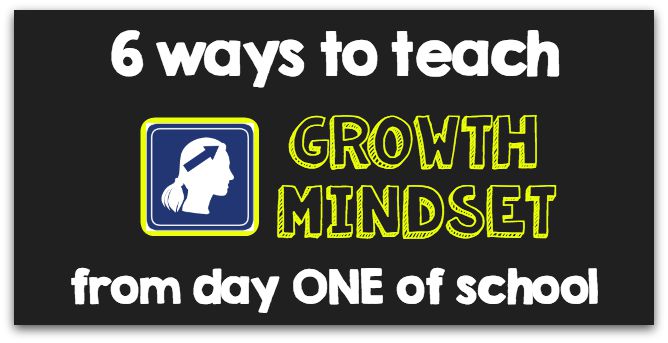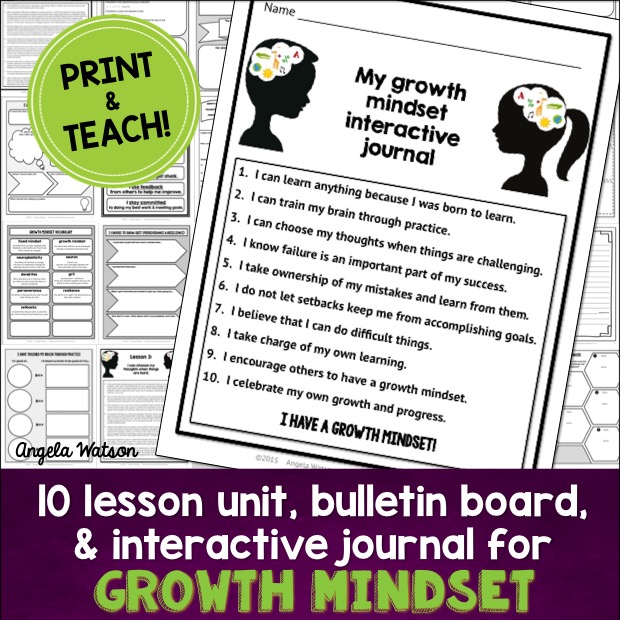Imagine if your new class this fall was full of students who would:
- Be willing to try new things
- Stick with hard tasks and not give up
- Push themselves to do their best work, not just what’s “good enough”
- Believe in themselves and their own ability to learn
Here’s the great news–these are traits that we can help develop in our students by teaching them about how their brains work.
Our students may not realize that their brains have the ability to change and grow through their experiences (neuroplasticity). Students need us to teach them that the human brain is like a muscle that can be trained through repetition and practice. When students realize this, they develop a growth mindset: the belief that abilities can be developed through commitment and hard work.
And once they have a growth mindset, they can learn anything.
Because a growth mindset is a critical element of success in school, I recommend teaching about it from the very first day. Here are 6 ways to do that:

1. As you teach classroom routines, explain how they are designed to benefit kids’ brains.
For example, when you teach students how to do collaborative learning activities, tell them that talking about what they’ve learned helps them own and process the information better, and grows more dendrites. When you teach water fountain procedures, let kids know that their brains need hydration in order to function well, and remind students of the benefits of drinking water.
2. When kids don’t follow the procedures you’ve taught, respond in casual ways that help them rebound.
When we overreact to mistakes or get frustrated with students’ inability to internalize classroom routines right away, we undermine our message that learning is a process and failure is a natural part of that process. Make it your goal to respond to students’ mistakes with patience and nonchalance. Remind students: Each time you practice this routine, your brain is getting stronger, and it will be easier for you to do it the next time. When kids forget what to do, let your tone and facial expression communicate: Mistakes don’t upset me. We can fix this, and fixing it together will make us both smarter.
3. Get student input on creating helpful classroom displays that reinforce learning.
You don’t have to start the school year with a perfectly decorated classroom–leave space for students to create and suggest displays! During the first few weeks of school, find out what students would like to have as a reference in the classroom to help them maintain a growth mindset and take ownership of their learning. Would students like to make an anchor chart with strategies they can use when they get stuck? Do they want to display growth mindset vocabulary words and definitions so they can try to use them in their conversations? Or maybe they’d like to display some of their reflections about or strategies for learning to help other kids in the class?
4. Use specific feedback and helpful vocabulary that guides students to identify how they achieved success.
We give tons of positive feedback and praise as students first start learning the expectations for the new grade level, but we don’t always point out the character traits students demonstrated in order to experience that success. Integrate growth mindset vocabulary into your daily routines, and continually point out when students demonstrate those qualities. You might say, “This was hard for you, but you persevered, and now you’ve almost got it!” or “You had a setback when your strategy didn’t work, but you found resources to help you. You showed a lot of resilience, and it paid off!” You may even want to end the school day on a daily basis by having students turn and share ways they have shown grit that day (or struggled to show grit, and brainstorm strategies for doing better tomorrow.)
5. Model growth mindset so kids can see it in action.
Show students how to respond constructively to setbacks and failures. Let kids see how you brainstorm solutions and different strategies to try when a piece of technology doesn’t work, you can’t find something you need, or a surprise fire drill prevents kids from finishing a task. Allow students see that you are willing to learn and try new things, even when they are hard for you, and be honest when you try things in the classroom that are out of your comfort zone. Let students see that learning new things, taking on challenges, and rebounding after making mistakes are all a natural part of life and help train your brain to grow stronger over time.
6. Start formally teaching kids about growth mindset / neuroplasticity through books, apps, and other resources.
Two of the best children’s books on growth mindset are Your Fantastic Elastic Brain by Dr. JoAnn Deak and Making a Splash: A Growth Mindset Children’s Book by Carol E. Reiley. There is a $4.99 app for “Your Fantastic Elastic Brain” which includes an eBook version of the book along with interactive features. Or, you might want to try the $2.99 Brain Jump appfor iPad and iPhone. I also like the free online brain songs provided by the University of Washington.
Want more structured support? I’ve created a complete 10 lesson unit with teacher’s guide, bulletin board set, printable posters, and a 20 page interactive student journal to provide everything you need for teaching your students about growth mindset. Designed for grades 3-5, this unit is highly flexible, and can be taught in any timeframe you’d like (I recommend one lesson per week during the first month of school, with the remaining six lessons spread out through fall and winter.)
Once you print the materials, your prep work is done and the teacher’s guide walks you step-by-step through each activity. However, the tasks are open-ended and adaptable so you can be responsive to your students’ needs and adjust things easily as you go.
How are you teaching students to have a growth mindset?

Angela Watson
Founder and Writer
OR

Join our
community
of educators
If you are a teacher who is interested in contributing to the Truth for Teachers website, please click here for more information.
















